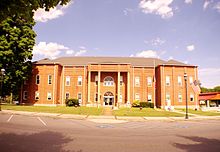Bledsoe County, Tennessee
| Bledsoe County, Tennessee | |
|---|---|

Bledsoe County Courthouse in Pikeville
|
|
|
Location in the U.S. state of Tennessee |
|
 Tennessee's location in the U.S. |
|
| Founded | 1807 |
| Named for | Anthony Bledsoe |
| Seat | Pikeville |
| Largest city | Pikeville |
| Area | |
| • Total | 407 sq mi (1,054 km2) |
| • Land | 406 sq mi (1,052 km2) |
| • Water | 0.3 sq mi (1 km2), 0.08% |
| Population | |
| • (2010) | 12,876 |
| • Density | 32/sq mi (12/km²) |
| Congressional district | 4th |
| Time zone | Central: UTC-6/-5 |
Bledsoe County is a county located in the U.S. state of Tennessee. As of the 2010 census, the population was 12,876. Its county seat is Pikeville.
Bledsoe County was formed in 1807 from land that was formerly Indian Land as well as land carved from Roane County. The county was named for Anthony Bledsoe (1739–1788), a soldier in the Revolutionary War and was an early settler of Sumner County. He was killed in an Indian attack at Bledsoe's Station.
Like many East Tennessee counties, Bledsoe County opposed secession on the eve of the Civil War. In Tennessee's Ordinance of Secession on June 8, 1861, the county's residents voted against secession by a margin of 500 to 197. General James G. Spears, a resident of Bledsoe, served as a vice president at the pro-Union East Tennessee Convention in May and June 1861, and fought for the Union Army in the war.
According to the U.S. Census Bureau, the county has a total area of 407 square miles (1,050 km2), of which 406 square miles (1,050 km2) is land and 0.3 square miles (0.78 km2) (0.08%) is water.
As of the census of 2000, there were 12,367 people, 4,430 households, and 3,313 families residing in the county. The population density was 30 people per square mile (12/km²). There were 5,142 housing units at an average density of 13 per square mile (5/km²). The racial makeup of the county was 94.44% White, 3.70% Black or African American, 0.38% Native American, 0.11% Asian, 0.02% Pacific Islander, 0.19% from other races, and 1.15% from two or more races. 1.12% of the population were Hispanic or Latino of any race.
...
Wikipedia
